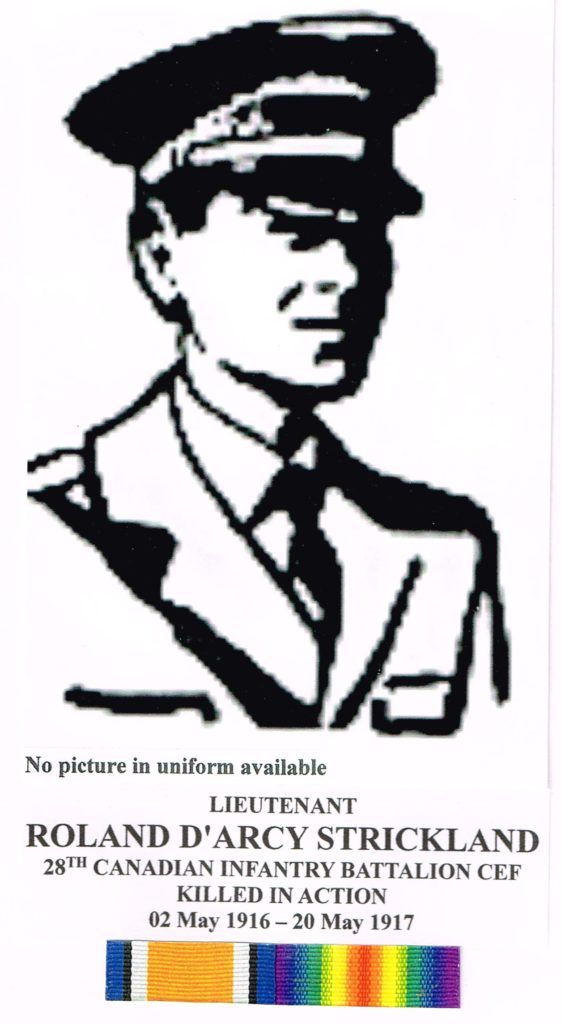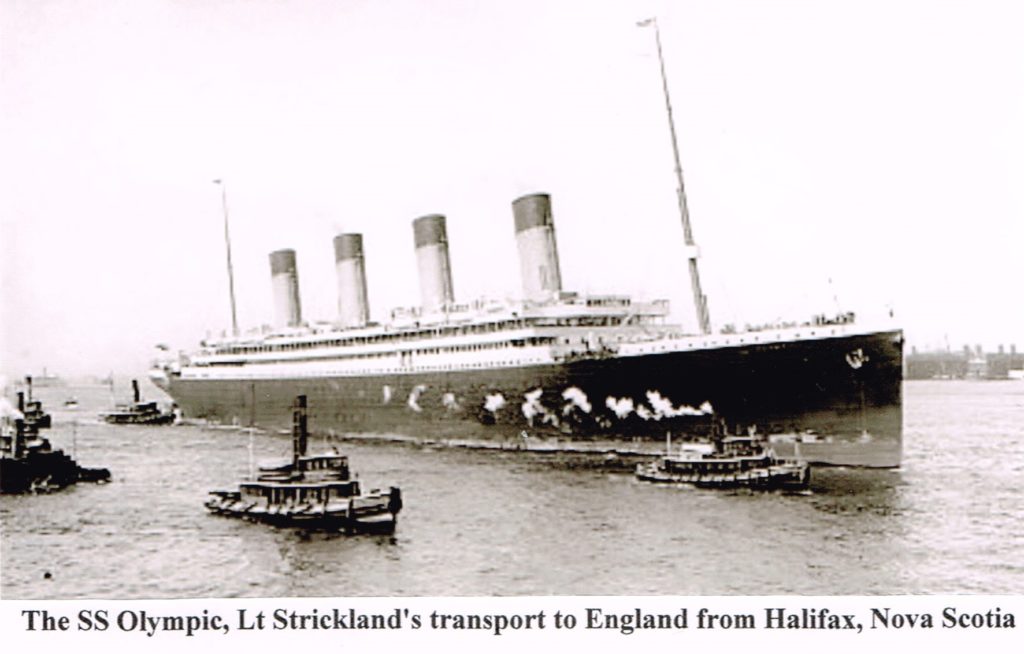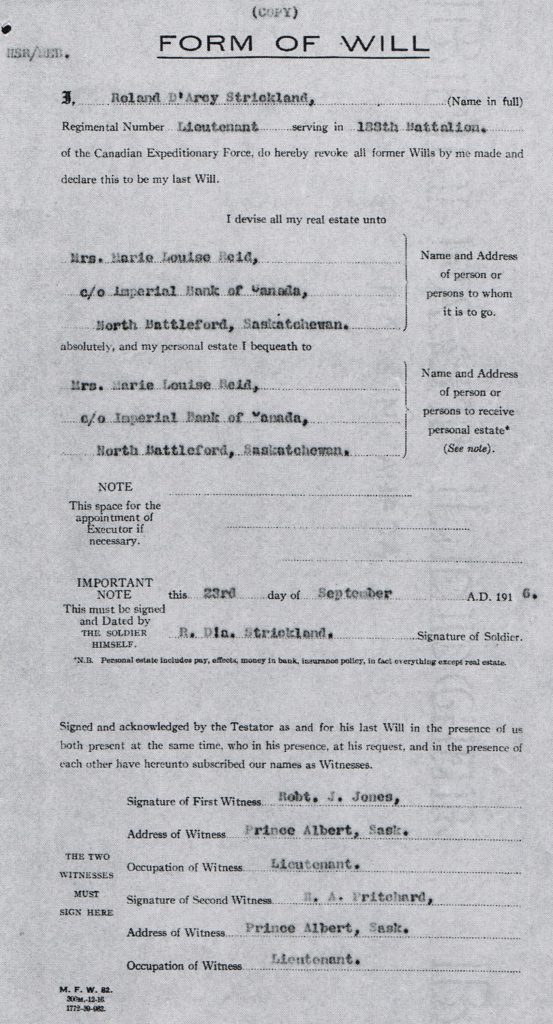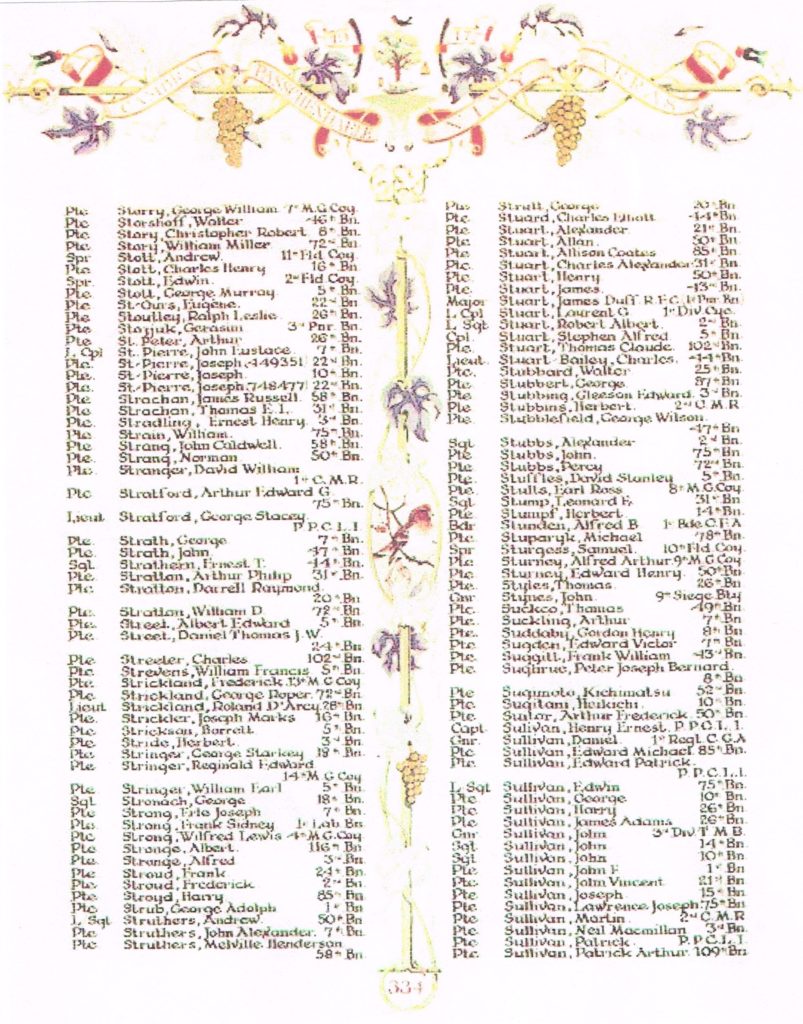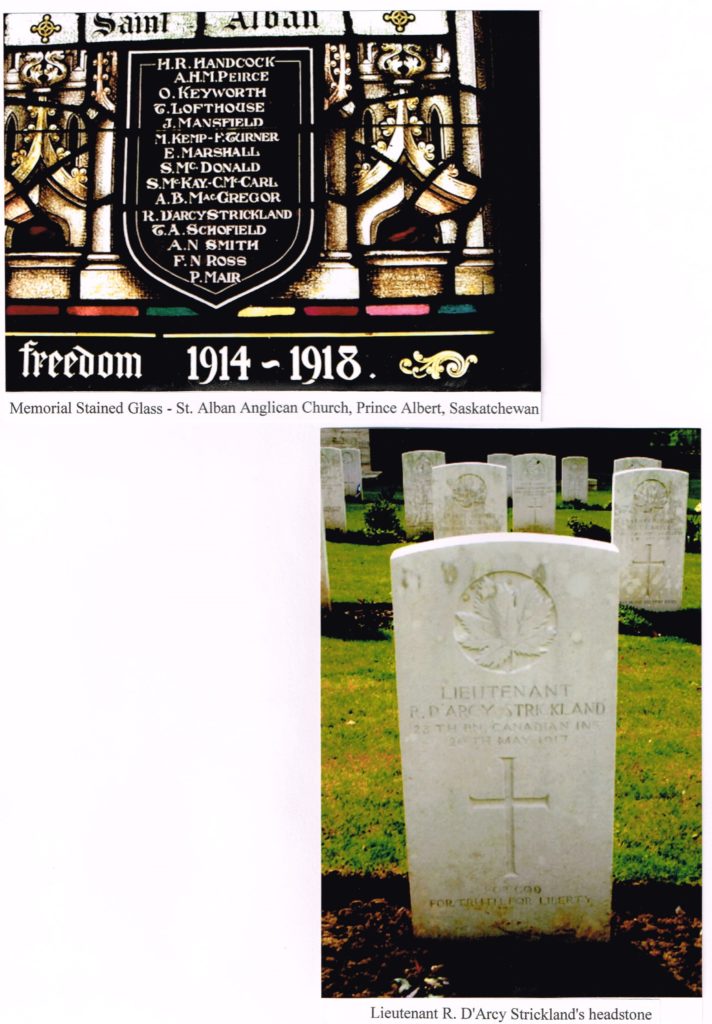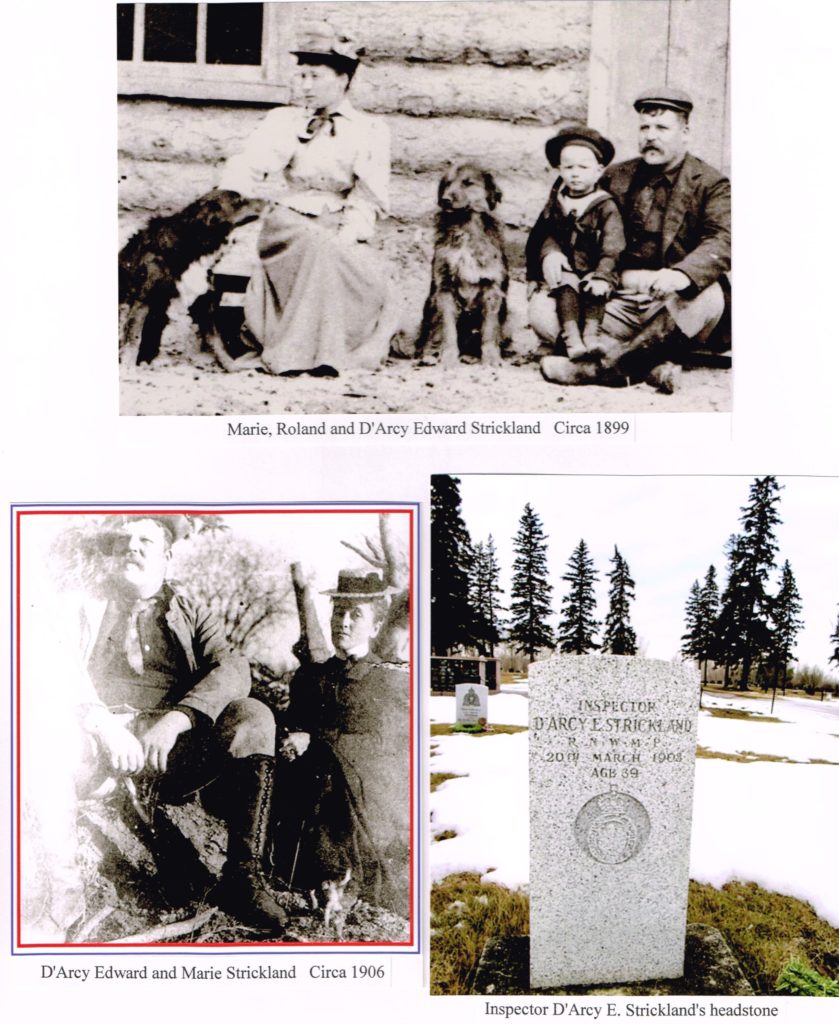MILITARY HISTORY
Lieutenant Roland D’Arcy Strickland —— ACTIVE SERVICE (World War I)
Roland D’Arcy Strickland completed the Officers’ Declaration Paper, Canadian Over-Seas Expeditionary Force (CEF) [O/S] on May 2, 1916. Roland D’Arcy was 20 years, 4 months and 17 days old when, as a single man, he filled out the Officers’ Declaration Paper in Peterborough, Ontario. Roland D’Arcy was born at Duck Lake, Saskatchewan and was living at North Battleford, Saskatchewan; his date of birth was December 15, 1895. Roland D’Arcy was 5′ 11″ tall, weighed 158 pounds and had a 38″ chest (expanded). His next-of-kin was his mother, Mrs. Marie Louise Reid* (his father had died suddenly in 1908), c/o Imperial Bank of Canada, Golden, British Columbia (BC) c/o Mrs. H. L. Reid, c/o Imperial Bank of Canada, North Battleford, Saskatchewan. He gave his professional occupation as a Bank Accountant. Roland D’Arcy’s Unit in the Active Militia was the 52nd Bn Prince Albert Volunteers. He had no former Military Service. Roland D’Arcy’s Medical Examination was done on May 2, 1916 in North Battleford. Roland D’Arcy Strickland was enlisted on May 2, 1916 with the 188th Canadian Infantry Battalion Overseas (Cdn Inf Bn) CEF (O/S) for the duration of the War and was assigned the Rank of Lieutenant (Lt). September 21, 1916 Lt Strickland indicated that he was insured by the Canada Life Insurance Company and Insurance Premiums are being paid. Lt Strickland embarked the SS Olympic at Halifax, Nova Scotia on October 12, 1916 and disembarked at Liverpool, England on October 19, 1916.
There is a gap in Lt Strickland’s File from October 20, 1916 to January 3, 1917. This period of time would have been utilized to do training in England with the 188th Cdn Inf Bn. January 4, 1917 Lt Strickland was transferred to the 15th Reserve Battalion (Res Bn) at East Sandling, England from the 188th Cdn Inf Bn and was taken-on-strength at Dibgate the same day. The Headquarters (HQ) CEF noted that Lt Strickland qualified 1st Class at the 51st Class of Musketry at Shorncliff from January 29, 1917 to February 16, 1917. On March 6, 1917 Lt Strickland was struck-off-strength from the 15th Cdn Res Bn and proceeded overseas (France) for service with the 28th Cdn Inf Bn. March 9, 1917 he was taken-on-strength with the 28th Bn on arrival from England.
April 1, 1917 Lt Strickland made a Pay Assignment of $60.00 monthly to Herbert Lestock Reid; only three would have been made as the account was closed on June 30, 1917.
May 20, 1917 the Canadian Records Office reported from the Base that Lt Strickland was killed in action at Rouen, France on May 20, 1917. June 1, 1917 Lt Strickland’s Estate would receive $841.08.
There is no mention in Lieutenant Roland D’Arcy Strickland’s File with regards to what Military Medals he was eligible to receive or was awarded. Based on his Military Service, he was awarded the:
British War Medal; and
Victory Medal.
He would have also received the CEF Class “A” War Service Badge.
Roland D’Arcy Strickland’s Memorial Cross was dispatched to his mother c/o Imperial Bank of Canada, Golden, on September 1, 1920. The Scroll was dispatched to his mother, Mrs. Marie Louise Reid, c/o Imperial Bank of Canada, Golden, BC on February 2, 1921. His Plaque was dispatched to his mother c/o Imperial Bank of Canada, Golden, on February 26, 1922. Roland D’Arcy Strickland’s Medals, Decorations were dispatched to his mother, Mrs. Marie Louise Reid, c/o Imperial Bank of Canada, Golden, BC on March 29, 1923.
Lieutenant Roland D’Arcy Strickland served for: 5 months, 10 days in Canada; 4 months, 14 days in the United Kingdom; 2 months, 14 days in France and 10 days Travel Time for a total time of about 1 year, and 18 days.
Lieutenant Roland D’Arcy Strickland is buried in the Ecoivres Military Cemetery; Pas-de-Calais, France. The location is as follows:
Mont St. Eloi is a village in the Department of the Pas de Calais, 8 kilometres north west of Arras. The village stands on high ground overlooking the battlefields of Vimy and Souchez and the main Bethune Arras road, and the ruined towers that rise from it were used as an observation post during the French attacks at Neuville St. Vaast and Givenchy in May 1915. Ecoivres is a hamlet lying at the foot of the hill, to the south west and about 1.5 kilometres from Mont St. Eloi on the Arras St. Pol line. The Ecoivres Military Cemetery is on the D49 road.
An excerpt from an article in McLean’s magazine by Barbara Amiel, September 1996:
The military is the single calling in the world with job specifications that include a commitment to die for your nation. What could be more honorable?
PERSONAL HISTORY
ROLAND D’ARCY STRICKLAND
Roland D’Arcy Strickland was born in Duck Lake, Saskatchewan on December 15, 1895. He was the son of D’Arcy Edward Strickland and Marie Louise Tannis Drever. When he enlisted with the Canadian Over-Seas Expeditionary Force on May 2, 1916, Roland was living in North Battleford, Saskatchewan and was employed as a bank accountant.
Sadly Roland D’Arcy Strickland was killed in action in France on May 20, 1917, and is remembered with honour in the Ecoivres Military Cemetery, Mont-St. Eloi, Pas-de-Calais, France.
THE ROLAND D’ARCY STRICKLAND FAMILY OF LAKEFIELD
Roland D’Arcy Strickland’s paternal grandparents were Roland Clement Strickland born in Lakefield in 1844 and Mary Jane Boulton born in Cobourg in 1846. Roland D’Arcy Strickland was a farmer, lumberman and owner of a Lakefield sawmill. They had a family of five children: D’Arcy Edward; Edith Julia; Clementine Katharine; Roland Hugh and Mary Strickland. Mary Jane Boulton died in childbirth on July 7, 1874, age 28 years and is buried in the Christ Church Cemetery, Lakefield. Roland Clement Strickland remarried Eleanor Susanna Crickmore in 1876 and they had seven children. Eleanor Susanna passed away on August 5, 1909 and Roland died June 10, 1929; both are buried in Hillside Cemetery, Lakefield, ON.
Roland D’Arcy Strickland’s maternal grandparents were D’Arcy Edward Boulton born in 1814 and Emily M. Heath born in 1817. They resided in the Cobourg area and D’Arcy was a Barrister and had a Military Career. They had a family of six children – Charles Arkoll, D’Arcy E., Alice M., Sarah, Mary Jane and George D’Arcy Boulton. D’Arcy Edward Boulton died in 1902 and Emily passed away in 1903.
Roland D’Arcy Strickland’s parents were D’Arcy Edward Strickland born in 1868 and Marie Louise Tannis Drever born in 1876. Roland graduated from Royal Military College in Kingston and joined the Northwest Mounted Police on November 15, 1891, as an Inspector, having previously served as the Adjutant in the rank of Lieutenant in “The Prince of Wales” Canadian Dragoons at Cobourg, Ontario. D’Arcy and Marie had two sons and a daughter James born in 1889, Roland born in 1895 and Frances Mary Strickland born in 1899. D’Arcy’s career had the family living in Lakefield in 1891, in Saskatchewan in 1901 and in 1906 the family was living in Edmonton, Alberta. At the time of his death, the family was living in Fort Saskatchewan, Alberta. D’Arcy Edward Strickland died in Fort Saskatchewan, Alberta on March 29, 1908 of cardial dropsy in diabetic heart failure at the age of 39 years. He is buried in the RCMP Cemetery. Marie Louise Strickland later married Herbert Lestock Reid. Marie passed away in 1950.
RCMP Veterans’ Association / Association des Vétérans de la GRC
INSPECTOR D’ARCY STRICKLAND REMEMBERED
WHITEHORSE, YT – March 20, 2018 – One hundred and ten years ago, on March 20, 1908, the Officer Commanding of the Royal North West Mounted Police post at Fort Saskatchewan, Alberta, suddenly passed away from “cardial dropsy” (cardiac edema) at the age of 39.
Although buried at that location in the Royal Canadian Mounted Police Cemetery, he is best known for his service in the Yukon before, during and after the Klondike Gold Rush.
Inspector D’Arcy Edward Strickland, 0.99 (Regimental Number), was born on November 2, 1868, at Lakefield, Ontario.
A graduate of the Royal Military College of Canada at Kingston, Ontario, he joined the North West Mounted Police on November 15, 1891, as an Inspector, having previously served as the Adjutant in the rank of lieutenant in the “The Prince of Wales” Canadian Dragoons at Cobourg, Ontario.
Inspector Strickland was posted to the Northwest Territories to “Depot” Division in Regina (now Saskatchewan).
In 1895, Inspector Strickland was the second-in-command, under Superintendent Charles Constantine, 0.79, of a party of 18 members of the Force sent out to establish a permanent police presence in the Yukon.
The expedition departed “Depot” at Regina (now Saskatchewan) on May 1, 1895, journeyed by train to the west coast and then by steamship to Juneau, Alaska, and then to the point on the Yukon River where they constructed Fort Constantine, described by Superintendent Constantine in January 1896 as being “the most northerly military or semi-military post in the British Empire.”
Inspector Strickland is prominent in the photograph taken of the NWMP party at Fort Constantine in 1895, wearing a white shirt and tie!
A big, beefy man who, judging from photographs taken of him preferred to not wear the regulation uniform, Inspector Strickland was adjudged by his disapproving superior (Superintendent Constantine) to be a fun-loving person, “what is generally known as a good fellow” with “a taste for low company [and] a decided fondness for drink.”
Inspector Strickland was accompanied to the Yukon by his wife Marie Tannis and their son Roland. Their daughter Frances would be born in 1899.
The summer after Fort Constantine was established gold was struck on Bonanza Creek which drains into the Klondike River and the Great Gold Rush was on.
Inspector Strickland was placed in charge of guarding the White Pass which, along with the Chilkoot Pass, was one of the main entry points for the thousands of gold seekers on the “Trail of ’98.”
He established and commanded the NWMP post at Tagish in 1897.
In 1902, Inspector Strickland left the Yukon to join the 5th Canadian Mounted Rifles, commanded by Lieutenant-Colonel (former Superintendent) Archibald Cameron MacDonell, 0.95, as the Unit’s “popular and energetic” Adjutant, to fight in the South African War.
The 5th CMR arrived at Durban, South Africa in May 1902 only to find that the war was over. Shortly after arriving, the Canadian troops were shipped back home to Canada, having never seen combat.
Inspector D’Arcy Strickland resumed his career in the Force as the Officer Commanding at Prince Albert, Wood Mountain and then Fort Saskatchewan, until his death on March 20, 1908.
His son whom he brought to the Yukon as a child, Lieutenant Roland D’Arcy Strickland, served in the First World War and was killed in action on May 20, 1917, while serving in the 28th (Northwest) Battalion of the Canadian Expeditionary Force.
He was 21 years old, and is buried in the Ecoivres Military Cemetery near Vimy Ridge in France.
Strickland Street in Whitehorse, Yukon Territory, and Mount Strickland and Strickland Lake are named for Inspector D’Arcy Edward Strickland.
We will remember him.
Mark Gaillard, Historian
RCMP Veterans’ Association
